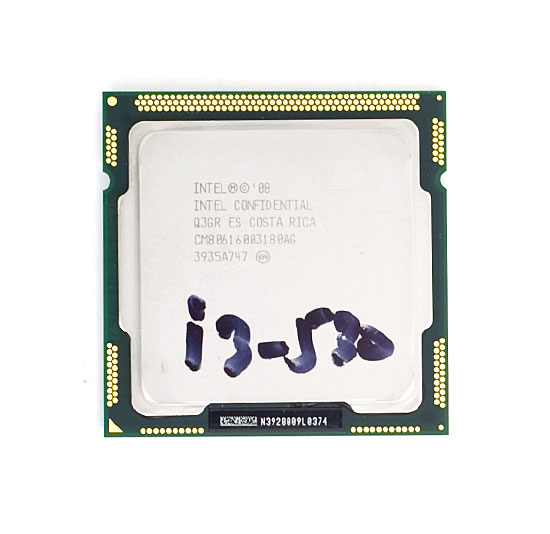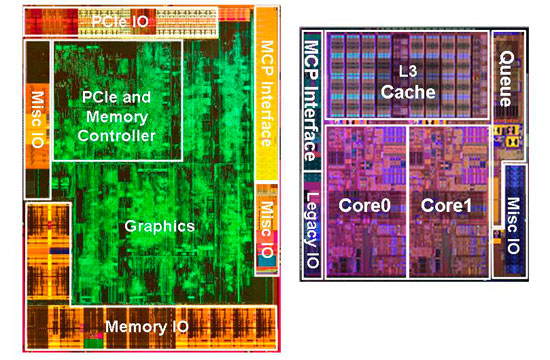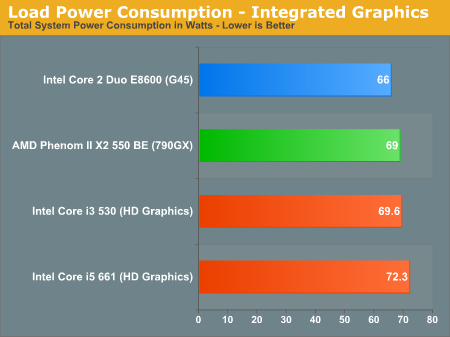The Intel Core i3 530 Review - Great for Overclockers & Gamers
by Anand Lal Shimpi on January 22, 2010 12:00 AM EST- Posted in
- CPUs
It’s about time we got an interesting value processor to review from Intel. I simulated one in our Clarkdale review, but today I’m bringing you a full review of the most interesting dual-core Westmere for the desktop - the Core i3 530.

Priced at $113 (and selling for about $125 on the street) the 530 runs at 2.93GHz and features no turbo modes. It’ll run at 1.33GHz at its lowest frequency, and no faster than 2.93GHz at full load. The missing turbo boost is almost all you sacrifice as the 530 still has a hefty 4MB L3 cache shared between both cores. Each core gets a 256KB 10-cycle L2, just like the i5s and i7s.
The un-core is clocked at 2.13GHz, down from 2.40GHz in the i5. That should hurt performance a bit compared to our simulated i3 in the launch article. Aside from Turbo the other thing you give up with the i3 is AES acceleration. Westmere's AES New Instructions (AES-NI) are disabled on all of the i3s in typical Intel fashion. There has to be some reason for users to opt for a Core i5 instead.
| Processor | Core | Un-core | GPU | Cores / Threads | L3 Cache | Max Turbo | TDP | Price |
| Intel Core i5-670 | 3.46GHz | 2.40GHz | 733MHz | 2 / 4 | 4MB | 3.76GHz | 73W | $284 |
| Intel Core i5-661 | 3.33GHz | 2.40GHz | 900MHz | 2 / 4 | 4MB | 3.60GHz | 87W | $196 |
| Intel Core i5-660 | 3.33GHz | 2.40GHz | 733MHz | 2 / 4 | 4MB | 3.60GHz | 73W | $196 |
| Intel Core i5-650 | 3.20GHz | 2.40GHz | 733MHz | 2 / 4 | 4MB | 3.46GHz | 73W | $176 |
| Intel Core i3-540 | 3.06GHz | 2.13GHz | 733MHz | 2 / 4 | 4MB | N/A | 73W | $133 |
| Intel Core i3-530 | 2.93GHz | 2.13GHz | 733MHz | 2 / 4 | 4MB | N/A | 73W | $113 |
| Intel Pentium G9650 | 2.80GHz | 2.00GHz | 533MHz | 2 / 2 | 3MB | N/A | 73W | $87 |
Sitting next to the 32nm CPU die is a 45nm GPU/memory controller:

Like the majority of the Core i5 processors, the GPU here runs at 733MHz. The exception being our recently reviewed 661 which runs the GPU at 900MHz for those who want that extra bit of mediocre gaming performance.
From Intel the closest competitor is the Core 2 Duo E7600, which runs at 3.06GHz but with a 3MB L2 cache. AMD provides the biggest threat with its Athlon II X4 630 and Phenom II X2 550 BE. The latter isn't on AMD's official price list but you can still find it online today for $99.
In a market full of good alternatives, whether it’s an ultra-cheap quad-core or a solid dual-core, it’s time to find out if there’s any value in the Core i3 530.
Fixes Since Last Time
There were two outstanding issues in our Clarkdale review that needed fixing after CES. First and foremost was power consumption. We incorrectly assumed that Clarkdale's idle power consumption was worse than Lynnfield due to the 45nm on-package chipset. As many of you pointed out, it was an issue with our ASUS H57 motherboard. After CES we switched over to Gigabyte's GA-HS57M-USB3 and the idle power consumption improved considerably. Since then ASUS appears to have fixed the problem but our data for this review was still run with Gigabyte's board.

Unfortunately these sorts of issues aren't rare with any new motherboard/chipset release. Our ASUS H57 board had idle power issues, while our Gigabyte H57 board had overclocking issues. No one seems to get it right on the first try.
The second issue that needs correcting is the system power consumption while playing back an x264 video using integrated graphics. Our AMD numbers were unusually high in our initial review, which we've since corrected:

While playing H.264 encoded video the GPU does all of the heavy lifting and there's no power advantage for Clarkdale to rest on. When watching a movie the AMD system is indistinguishable from our Clarkdale test bed.
We are still running into an issue with MPC-HC and video corruption with DXVA enabled on the 790GX, but haven't been able to fix it yet. Have any of you had issues with video corruption with AMD graphics and the latest stable build of MPC-HC for 64-bit Windows? Or should we chalk it up to being just another day in the AnandTech labs.










107 Comments
View All Comments
dandar - Saturday, January 23, 2010 - link
Bought 3-pack of win7 pro and these things run beautiful. Fast, win xp mode is supported so every app they had back with win xp still runs. I'm very happy with this platform from Intel. This was a home run in my opinion.raced295 - Friday, January 22, 2010 - link
Correct me if I'm wrong but I thought it was well understood that Intel uses processor power to accelerate gpu functions. In other words the GPU is not nearly as fast as is appears the drivers offload work to the cpu since it is very powerful. I will try to post links to support this but don't remember them off hand as I thought this was common knowledge on "in depth" sites such as this. I believe that this was going on in part on G45 at least with benchmark software. Also that the driver looks for benchmark exe's and game exe's and manipulates quality and offloads to CPU.It doesn't change much for the end user as its still faster but bottom line I don't think the GPU is as good as it appears. Net performance however is as good as it has shown and this is brilliant of Intel to do.
Submit to the community for thought.
MrSpadge - Friday, January 22, 2010 - link
So the integrated GPU can be overclocked really high. Nice, but we're not gaming on this thing anyway.No, what this really means is that the GPU voltage is set unnecessarily high by Intel! We'd be using these integrated GPUs to save power compared to discrete GPUs, not to waste it. It doesn't have sophisticated power management yet, but at least a reasonable voltage would be nice..
sandman1687 - Friday, January 22, 2010 - link
On the fourth page it says that overclocking without increasing the voltage will not increase power consumption. This is not true; while power is directly proportional to frequency, exponentially to voltage. Could you post some idle and load power figures when overclocked at 4 and even 3.3GHz? I'm always hesitant to raise the CPU voltage. Thanks.-sanders
Rajinder Gill - Saturday, January 23, 2010 - link
As power consumption and efficiency has become more important, and manufacturing processes improved, how far you can push a CPU without increasing its core voltage appears to be the most efficient way to overclock. You minimize any increases in power consumption while maximizing performance.It does not say the power consumption will not increase, but that you will somewhat minimize the increase by keepingthe voltage at stock.
regards
Raja
MrSpadge - Saturday, January 23, 2010 - link
You're right, but one also needs to keep the absolute value of the stock voltage in mind. A fine example are the initial 45 nm Phenom II chips: reviewers applauded them for being able to OC rather high at stock voltage. However, "stock" in this case meant 1.35 - 1.40 V. That's more or equal to the maximum Intel gave it's 65 nm chips.So either one could argue "great stock voltage OC" or one could say "wasting power by setting a unnecessarily high stock voltage".
MrS
MrSpadge - Friday, January 22, 2010 - link
P ~ V^2, not exponential. Some leakage currents scale stronger, but these don't dominate the overall power draw (otherwise the process / design would be pretty bad).sandman1687 - Friday, January 22, 2010 - link
Sorry, meant quadratic.Finally - Friday, January 22, 2010 - link
I compared power draw under LOAD for the Phenom II 965 BE and here: http://www.anandtech.com/cpuchipsets/showdoc.aspx?...">http://www.anandtech.com/cpuchipsets/showdoc.aspx?... you say it draws 274W (sic!), while in your database the same figure is much lower. How come?janm9 - Friday, January 22, 2010 - link
i am looking for the power consumption of the an amd athlon x4 620/605e with the 785G chipset. i can not find a review using just onboard graphics. the anandtech benchmark database is nice, but it only lists power consumption with either the 5870 or geforce 280gtx.i myself have run into problems ( artifacts ) under windows 7 with both media center and MPC-HC in 64bit with DXVA too.
thank you for writing an interesting article :)